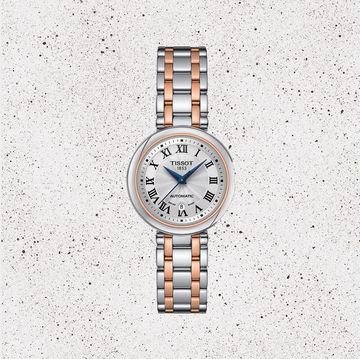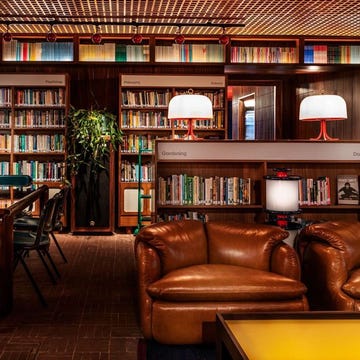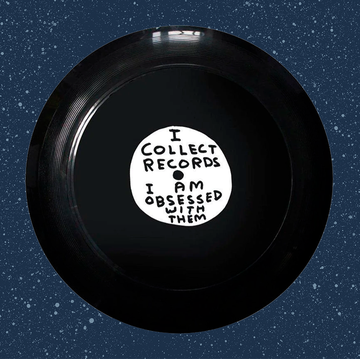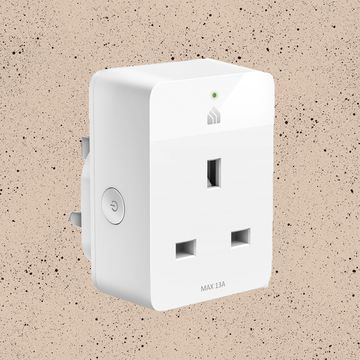'A man yearns for quarters of his own. More than a place to hang his hat, a man dreams of his own domain, a place that is exclusively his'
— Hugh Hefner, Playboy, September 1956
Say what you like about Hugh Hefner, RIP, but there was a man who understood the importance of a well-plumped cushion. For amid the obituaries and hullabaloo that followed the death of the Playboy tycoon, one small contribution to world culture Hefner made has been left unnoticed: interior design.
In its September 1956 issue, Playboy magazine ran its first feature on the perfect man's home. It was a pad, of course, for "the urban bachelor," wrote Hefner, "a man who enjoys good living, a sophisticated connoisseur of the lively arts, of food and drink, and congenial companions of both sexes. A man very much, perhaps, like you." In 1956, men — certainly heterosexual men, certainly playboys — were not supposed to have opinions about interior design, not ones they actually voiced, let alone published. They were not really meant to have opinions about the home at all. They (rarely their wives) might own a home. They might lay their head down after a hard day's work in a home. But the home was not theirs. The home was the woman's domain, as it had been for two centuries. Men were just lodgers (though, admittedly, they did rule the rest of the universe beyond the front door, so let's not feel too sorry for them).
In 1956, remember, America was in the throes of a suburban revolution, its cities ballooning by the minute with picket fences and "ideal homes" lived in by bored housewives hooked on Valium and, usually late home from the office, their equally bored husbands, hooked on bourbon. Don and Betty Draper. The American Dream.
Hefner, like Don Draper, had another dream, a dream of freedom, for men at least. Wives would still be tethered to the pills and the kitchen sink for some time, but men were offered an escape, a new kind of home — a playground. Hefner's perfect bachelor pad was in the city. It had no "cell-like rooms" (words pointedly chosen), like the suburban detacheds his playboys were escaping, but an open plan of different "zones", in which the bachelor could, in Hefner's words, "perform for an admiring audience", act out different versions of himself other than the standard roles on offer to him at the time: the adulterous husband, say, the Marlboro Man, DIY dad.
He could, for instance, cook. Cooking, like taking an interest in soft furnishings was, in 1956, not something a real man was meant to do, unless French. In the Playboy pad, though, he could dazzle his audience with crêpes flambées. He could take an interest in design, too, for the playboy was allowed to shop, at least for some things, like shelving systems and designer chairs, not loo rolls and coasters. Not that you'd guess it from the look of this apartment's "unique kitchen stool", "constructed from a rugged, contoured tractor seat" (ew, no thanks). But the playboy was at least acquainted with Charles and Ray Eames. He had read his Le Corbusier. Why? Because this man also reads something other than the sports pages. His perfect apartment has at its heart a study, "the sanctum sanctorum", wrote Hefner, for the studying of Corbusier, Saul Bellow and pornography.
There are gadgets — of course there are — though the stereotype of a geek glued to tech in his man cave is still novel in 1956. My favourite: an "ultrasonic dishwasher", which "uses inaudible hi-fi sound to eliminate manual washing." We're still waiting for that particular gizmo to hit Currys. This apartment, though, does have built-in speakers, remote-controlled hi-fis and buttons that "control every light in the place". There's a "control panel" in his bed's headboard, too, which, at the touch of a button, rather creepily locks the front door and windows, not because Hefner is rightly concerned about security in the big bad city, but to ensure his quarry doesn't escape. For be in no doubt that this bachelor pad has only one function: it is a spider's web, its well-plumped cushions and concern for design designed for seducing a woman (never a wife; NEVER another man).
So, yes, guess what, the Playboy bachelor is hardly a pioneer of second-wave feminism. Note that this "perfect man's home" is a "place that is exclusively his". There's no room for wives, or partners of any persuasion, to move in, only to visit as "congenial companions". Kids? You kidding? Hefner widened the role models available to men at home beyond the adulterous husband, the Marlboro Man, DIY dad, true — the creepy lothario in the spiders' web, perhaps, the design buff with low-level OCD, the geek in his man cave — but he didn't widen the repertoire any further. His playboys are still basically lodgers in their own homes, roving commitment-phobes settling only briefly in a domestic setting for sex, an Old Fashioned and, if I must, maybe an hour or three of sleep. Basically, James Bond (published four years before the Playboy pad). Or, a decade later, Alfie.
The very idea that an aspiring man, "a man very much, perhaps, like you," might want to enjoy not escape their home was hardly new. From Ancient Rome through to the golden age of the British stately home in the 18th century, men usually lived and worked at home, if they were lucky to have a home at all; and those of means spent fortunes on and took interest in making that home look amazing. Their home was an extension of their selves. Even in the classic stately home, though, there were gender rules, as any keen observer of Downton Abbey can see.
The drawing room was a woman's space, decorated in pale "feminine" colours (pinks, yellows) and prints (florals), where women "withdrew" after dinner to drink tea and exchange significant looks. The dining room was a man's space, decorated in geometric prints and dark "masculine" colours (reds, and, if you can call it a colour, brown), where the men stayed after dinner to smoke cigars, discuss grouse shooting and stiffen their upper lips. And so began centuries of stereotypes. Women = flowers. Men, you can have any colour so long as it's brown. Maybe black. Fabrics for the ladies. Horny leather and wood for the boys.
It was the Industrial Revolution that separated work from home, the public from the private, and condemned men and women to their respective prisons. So, by 1956, the very fact that a home appeared in a men's magazine at all remains — to this day — a quietly radical act, progress of a kind. Playboy continued for decades to publish articles and photo shoots about the home, design, more ideal pads ("The Weekend Hideaway", "The Playboy Townhouse"...), and advice, yes, on the correct positioning of correctly plumped cushions on the well-bred man's sofa (never at an angle). Through it, and other pioneers in the Fifties and Sixties like Terence Conran, our idea of what masculinity in the home might be subtly shifted. And then stalled.
Today, men are generally offered exactly the same role models of how to be at home they were offered in 1956. The creepy lothario in the spider's web, the design buff with low-level OCD, the geek in his man cave. The latter, in particular, has risen to cultural prominence. Just watch any film starring Seth Rogan or Simon Pegg, or the shit-tips, albeit intellectual's shit-tips, inhabited by Sherlock Holmes or Doctor Who. The design buff with low-level OCD, though, came out big time in the Nineties when Grand Designs first aired, only this time cross-bred with that older male stereotype the playboys were trying to escape — DIY dad — giving birth to the New Man, manly enough to hew pine trees, sensitive enough to apply moisturiser and have an opinion on kitchen worktop surfaces, but not so sensitive to care about cushions.
Our ideas about masculinity, though, have flourished, and are flourishing. It is an ongoing project, of course, as the unending presence of Piers Morgan in our lives proves. But, we moisturise. We exfoliate. We work out. We come out. We wax. We read first, second, third-wave feminism. We are aware of the socially constructed nature of gender identity. But taking an interest in our homes still seems weirdly taboo, like an assault on some mythical masculinity. Like it was 1956.
But I know this is a lie. Why? I have the statistics. International Wallpaper Week took place in October. You didn't know? See how imprisoned you are in your masculinity? Or, hold on, did you secretly know but were too scared to say? Because a poll of 1,500 people during the week found that 85 per cent of men are actively (and, before you ask, willingly) involved in the interior design of their homes. The average man (again, of his own free will) shops for things for the house at least three times a month, artwork, throws and fresh flowers being among his top purchases. Forty-eight per cent of men regularly shop for scented candles. And I, reader, am one of them (I like the posh smelly ones, too, so there). Though I've never actually seen my fellow 48 per centers at the till. A glorious 54 per cent buy cushions. I confess: I have indeed bought cushions. While 53 per cent of men say they spend more money on homewares than on nights out, clothes, and, shame on you, technology. We even spend more than women: £1,304 a year versus £1,141.
Not that this appears to have made home life any more harmonious. Indeed, having opinions about interior design seems to have added to domestic discord, perhaps because 47 per cent of men reckon they have a better eye for interior design than their partners and are probably not shy of saying so. I'm frankly astonished that only 30 per cent of men have argued with their partners over decisions in a furniture shop or DIY store, though less astonished (from personal experience) that rows at home tend to focus on wallpaper design, how to make the bed correctly and a failure to plump sofa cushions. I'm with Hugh Hefner on this.
There are ulterior motives, as there were with the design of the Playboy pad. Of men polled, 85 per cent think a stylish home will help them attract the opposite sex (and, I'm sure, the same one). But, the survey concluded, there does seem to be a genuine interest in the home, and a generational shift in attitudes. It's OK, men. You can like wallpaper. And, the best bit? You don't have to put it up. You can get a man in. Or a woman.
I know, we shouldn't trust one poll. But even if it's halfway correct it shows, not before time, that something is changing. We just have to be out and proud about it. As in so many aspects of modern manners, Kanye West shows us the way. West has opinions about design, and he's not afraid to share them. Indeed, "the world," he told Harvard University design students in 2013, "can be saved through design."
West has collaborated with design luminaries like Peter Saville and Rem Koolhaas, and takes a particular interest in where he lives, in the manner of an 18th century aristocrat. In one of his early homes, an apartment in Manhattan, he went full-on minimalist, employing architect Claudio Silvestrin to deliver monastic bling. Last year, he was reportedly so aghast at the furniture choices made for his Calabasas home by interior designer Sandy Gallin, he immediately removed the offending items, and, when it was clear he couldn't return them to the shops, put them in storage and bought some more.
Kim Kardashian West, it was reported, is becoming rather "annoyed" by her husband's interior design opinions and the amount of money he is spending on them. Though there are options for the tighter budget. Last year, West told BBC Radio 1 he wanted to collaborate on furniture with Ikea: "Yo Ikea, allow Kanye to create." The Swedish homewares giant responded on Facebook with a mock-up Yeezy bed, "Hej Kanye, we'd love to see what you'd create... we could make you Famous!"
Men, if Kanye West says it's OK to like interior design, it's OK to like interior design. You don't have to be a playboy. You don't have to be DIY dad. There are other ways to be a man. There are other ways to live at home. It's OK not to like interior design, too. Your man cave can smell like Jeremy Clarkson's underpants. What do I care? Just be happy with who you are and where you live. And if you love cushions (plumped, though, and never at an angle), say it loud. I love cushions (plumped, though, and never at an angle)! I love scented candles! I love antimacassars! No, hold on, that's just weird.














